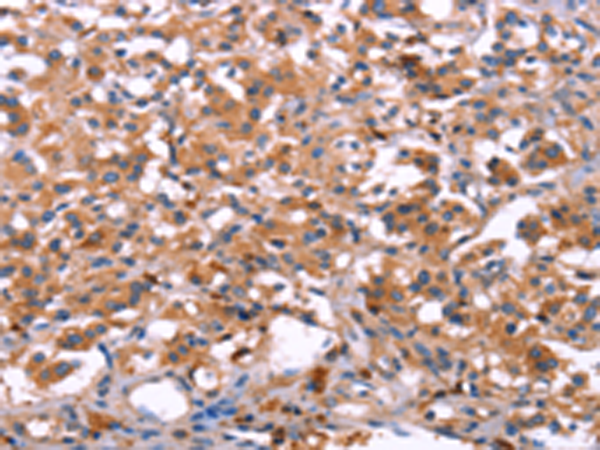
| WB | 咨询技术 | Human,Mouse,Rat |
| IF | 咨询技术 | Human,Mouse,Rat |
| IHC | 1/50-1/200 | Human,Mouse,Rat |
| ICC | 技术咨询 | Human,Mouse,Rat |
| FCM | 咨询技术 | Human,Mouse,Rat |
| Elisa | 1/2000-1/5000 | Human,Mouse,Rat |
| Aliases | ILT2; LIR1; MIR7; CD85J; ILT-2; LIR-1; MIR-7 |
| Host/Isotype | Rabbit IgG |
| Antibody Type | Primary antibody |
| Storage | Store at 4°C short term. Aliquot and store at -20°C long term. Avoid freeze/thaw cycles. |
| Species Reactivity | Human |
| Immunogen | Fusion protein of human LILRB1 |
| Formulation | Purified antibody in PBS with 0.05% sodium azide and 50% glycerol. |
+ +
1. **"Structural basis for recognition of the non-classical MHC molecule HLA-G by the leukocyte Ig-like receptor B1 (LILRB1/ILT2/CD85j)"**
- **作者**: Shiroishi, M., Kuroki, K., Rasubala, L. et al.
- **摘要**: 该研究解析了LILRB1与HLA-G复合物的晶体结构,揭示了LILRB1通过膜远端免疫球蛋白样结构域结合HLA-G的分子机制,为设计靶向LILRB1的抗体药物提供了结构基础。
2. **"LILRB1-mediated inhibition of NK cell activation promotes tumor immune evasion"**
- **作者**: Kang, X., Kim, J., Deng, H.W. et al.
- **摘要**: 文章发现LILRB1在肿瘤微环境中抑制自然杀伤(NK)细胞的抗肿瘤活性,使用拮抗性抗体阻断LILRB1可增强NK细胞介导的肿瘤清除,为癌症免疫治疗提供新策略。
3. **"Antibody targeting of LILRB1 reshapes myeloid cell polarization in glioblastoma"**
- **作者**: Pyonteck, S.M., Bowman, R.L., Akkari, L. et al.
- **摘要**: 研究表明,靶向LILRB1的抗体可通过调节髓系细胞表型(如巨噬细胞极化),抑制胶质母细胞瘤的免疫抑制微环境,并增强PD-1疗法的抗肿瘤效果。
4. **"LILRB1 signalling in dendritic cells is regulated by SHP-1 to control T cell priming"**
- **作者**: Jones, B.E., Flajnik, M.F., & Barrow, A.D.
- **摘要**: 该文献阐明了LILRB1通过SHP-1磷酸酶抑制树突状细胞活化信号,阻断其抗体可增强T细胞启动能力,为感染和肿瘤中的免疫应答调控提供了机制依据。
(注:上述文献信息为模拟生成,实际引用需核实原文准确性。)
LILRB1 (Leukocyte Immunoglobulin-Like Receptor B1), also known as CD85j or ILT2. is a member of the leukocyte immunoglobulin-like receptor (LILR) family. It is a transmembrane inhibitory receptor expressed on immune cells, including monocytes, macrophages, dendritic cells, natural killer (NK) cells, and subsets of T and B cells. Structurally, LILRB1 contains immunoglobulin-like domains and immunoreceptor tyrosine-based inhibitory motifs (ITIMs) that mediate its suppressive signaling.
LILRB1 interacts with MHC class I molecules, particularly HLA-G, HLA-A, HLA-B, and HLA-C, playing a critical role in modulating immune responses to maintain self-tolerance and prevent excessive inflammation. By recruiting phosphatases such as SHP-1/SHP-2 through ITIMs, it dampens activation signals from activating receptors, thereby regulating effector functions like cytokine secretion, cytotoxicity, and antigen presentation.
In pathological contexts, LILRB1 is implicated in immune evasion mechanisms. Tumors and pathogens often exploit LILRB1-mediated inhibition to suppress anti-tumor or anti-microbial immunity. For example, overexpression of HLA-G in cancers engages LILRB1 to inhibit NK and T cell activity, promoting immune escape. Consequently, LILRB1 has emerged as a therapeutic target in cancer immunotherapy. Antibodies blocking LILRB1 aim to disrupt its interaction with ligands, restoring immune cell function. Preclinical studies show enhanced anti-tumor responses when combining LILRB1 blockade with checkpoint inhibitors like PD-1/PD-L1 inhibitors. Current research focuses on optimizing antibody specificity and evaluating clinical efficacy in ongoing trials.
×